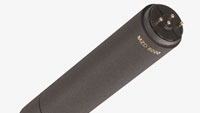Sennheiser's MKH 8000 goes digital

Sennheiser introduced the MZD 8000 digital module for the MKH 8000 Series at InfoComm 2009. This allows the MKH 8000 series to be digitalized directly at the microphone head, ensuring a natural sound without any loss of quality.
A warm, natural and powerful sound is what makes the MKH 8000 series really stand out. The new digital module ensures that this sound is maintained in full quality along the entire signal chain, in contrast to conventional digitalization, which uses a separate analogue/digital converter at some stage along the chain. The MZD 8000 digital module eliminates cable losses and features a converter and surrounding circuitry that have been optimally matched to the microphone.
The compact MZD module is simply screwed onto the microphone head in place of the XLR module. Like all signal-carrying components in the 8000 Series, the module is designed with two channels and converts the microphone signal according to the AES 42 standard, turning the audio signal of the MKH 8020 (omnidirectional), MKH 8040 (cardioid) and MKH 8050 (super-cardioid) into a digital one. Signal disruptions caused by interference or cable capacitance are almost totally eliminated, because digitalization takes place directly behind the microphone head.
In addition to the A/D converter (24-bit and sampling rate up to 192kHz), the digital module contains a DSP unit that, with the aid of dedicated PC control software and an AES 42 interface, allows microphone settings such as the low-cut filter, attenuation and limiter to be remote-controlled. The interface also provides the phantom power and word clock for synchronizing the microphones. Alternatively, the microphones can be synchronized using an external word clock.
Get the TV Tech Newsletter
The professional video industry's #1 source for news, trends and product and tech information. Sign up below.
